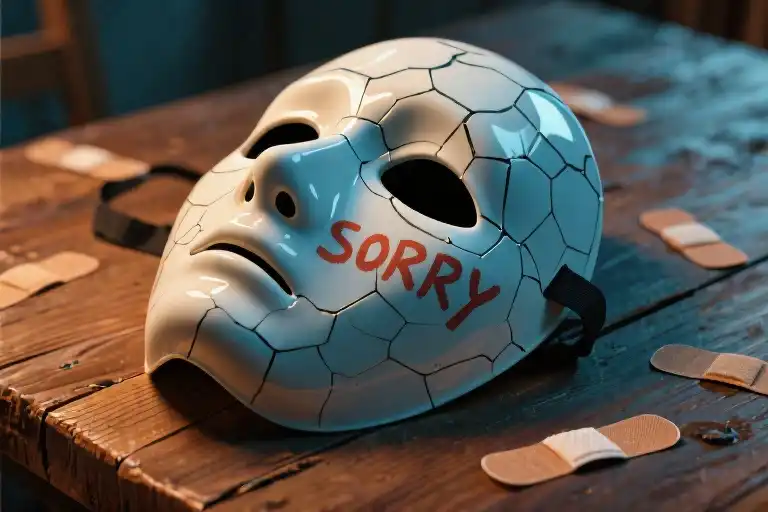The cursor blinked relentlessly on my screen, mocking the certainty I thought I possessed when I first typed out the title: Forgive Yes, Forget Never. My fingers hovered over the keyboard, their usual steadiness betrayed by a faint tremor. A drop of ink—no, a tear—splashed onto my notebook, blurring the angry underlines I’d drawn beneath those words hours earlier. That’s when it hit me: the cage I’d been trying to escape wasn’t built by others. The real prison was my own unforgiving heart.
This article began as another manifesto about boundaries, another battle cry urging readers to armor up against those who wronged them. I’d scribbled phrases like ‘Their choices don’t define you’ and ‘Protect your peace at all costs’—sentiments we’ve all heard in self-help bestsellers and Instagram affirmations. But as my pen dug deeper into the page, the narrative fractured. The ink bled into truths I hadn’t planned to confront.
Self-forgiveness—the term felt foreign even as I typed it now. We’re so conditioned to frame forgiveness as something we bestow upon others, a moral high ground we’re pressured to claim. Rarely do we discuss the quiet violence of self-betrayal: the way we replay our pain not just to condemn those who caused it, but to punish ourselves for allowing it. Why didn’t I see the signs? Why did I trust them? Why wasn’t I enough?
The irony? In drafting that original title, I’d unknowingly replicated the very dynamic I sought to dismantle. Forgive them (a performative release), but never forget (a life sentence for myself). The unspoken third clause? Never let yourself off the hook either.
Here’s what no one tells you about healthy boundaries: they crumble when built on the fault lines of self-condemnation. You can exile every toxic person from your life and still feel suffocated—because the voice hissing ‘You should have known better’ follows you everywhere.
That tear on my notebook wasn’t weakness; it was the first crack in a dam. For years, I’d weaponized my resilience, wearing my unbrokenness as proof that I’d ‘healed.’ But healing isn’t the absence of pain—it’s the courage to tend to the parts of us we’ve left frozen in time, still braced for battle.
So I invite you into this messy, unscripted emotional healing process. Not to teach you how to forgive them, but to explore why forgiving yourself feels so impossible—and why it’s the only path to true liberation. Because somewhere between ‘Forgive yes’ and ‘Forget never’, there’s a third option we rarely consider: ‘Release yourself.’
The Right to Righteous Anger
Society often tells us that anger is dangerous—an emotion to be suppressed, avoided, or quickly resolved through forgiveness. But what if I told you that your anger isn’t the problem? That in rushing to forgive others, we may be committing emotional treason against ourselves?
The Three Costs of Forced Forgiveness
- Emotional Compression
When we bypass anger to perform premature forgiveness, we create pressure cookers of unprocessed pain. Research shows suppressed anger correlates with increased cortisol levels—literally making us sick with unfelt feelings. That migraine after your coworker took credit for your idea? It might be your body’s protest against your forced smile. - Relational Distortion
I once coached a client who kept ‘understanding’ her mother’s emotional blackmail (‘She had a hard childhood’). This created a bizarre dynamic where the abuser received compassion while the victim absorbed shame. Healthy relationships require accountability, not asymmetrical forgiveness. - Self-Doubt Spiral
The most insidious cost? That whisper asking, Why can’t I just get over it? We judge our anger more harshly than the original offense. My ‘Healthy Anger Checklist’ includes this radical question: Are you mad at yourself for not getting angry sooner? (Most clients gasp when they realize their answer is yes.)
Case Study: The Good Daughter Syndrome
Maria’s story haunts me. For years, she financially supported her manipulative brother while repeating, Family comes first. When she finally set boundaries, the family accused her of holding grudges. Notice the language—her legitimate anger was framed as moral failure. Through our work, Maria discovered her real struggle wasn’t forgiving her brother, but forgiving herself for believing she deserved such treatment.
Anger as Emotional Cartography
Think of rage as your psyche’s GPS—it pinpoints where your boundaries were violated. That heat in your chest when recounting the betrayal? That’s not bitterness—it’s your self-preservation system working perfectly. The goal isn’t to extinguish this fire, but to let it illuminate what needs protecting.
Boundary Flame Test
When anger arises, ask:
- What value was violated here? (E.g., fairness, respect)
- Where else in my life have I felt this? (Pattern recognition)
- What would I demand for someone I love in this situation? (Self-worth calibration)
We’ll explore how this fiery phase naturally cools into awareness in our next chapter. For now, practice saying aloud: My anger isn’t the problem. The problem is what made me angry.
The Blind Spot of Self-Betrayal
My notebook still bears the indentation where my pen pressed too hard while writing “they should’ve known better.” What surprised me wasn’t the anger—it was discovering three pages later that my handwriting had shrunk when scribbling “maybe if I’d been more…” That subtle shift from fury to self-blame revealed what decades of personal development books never taught me: our deepest betrayals often happen in the quiet moments when we turn against ourselves.
The Silent Language of Self-Punishment
Before we can practice self-forgiveness, we must recognize how we unconsciously perpetuate our own pain. These aren’t dramatic gestures but micro-behaviors:
- The Lip Bite: Catching yourself physically restraining words of self-advocacy
- Mirror Avoidance: Skimming past reflections like a skipped track on an album
- Preemptive Apologies: The verbal flinches before stating needs (“Sorry to bother you, but…”)
- Hunched Shoulders: Your body’s ledger of carried burdens
During my therapy training, I created an exercise called “The Responsibility Pie Chart” that changed everything. Draw a circle and divide it into slices representing who truly owned each element of a painful situation. Most clients discover they’ve been claiming 80% slices for circumstances entirely outside their control—like blaming themselves for not predicting someone else’s cruelty.
My Wake-Up Call in a Coffee Shop
I’ll never forget the Wednesday morning my own mechanisms crystallized. When a barista mistakenly gave my preferred seat to another customer, my automatic response was “No worries!” while my stomach knotted. Later, journaling about why a trivial incident bothered me, I uncovered a childhood pattern: at seven years old, I’d learned to say “It’s okay” when my feelings were trampled to maintain peace in a volatile household. Three decades later, my nervous system still reacted as if expressing disappointment might cause emotional earthquakes.
This is the paradox of healthy boundaries—we think they’re about keeping others out, but first we must notice where we’ve abandoned ourselves. The work isn’t about assigning blame, but recognizing where we’ve internalized false responsibility.
The Forgiveness Audit
Try this reframing exercise I use with clients:
- Recall a situation where you feel someone wronged you
- List every “if only I had…” thought about it
- For each item, ask: “Would I expect a loved one to have that same level of foresight/control?”
Ninety percent of self-blame collapses under this simple question. What remains are the actual, rather than imagined, areas for growth—and those become gifts rather than weapons.
The moment I truly grasped self-forgiveness wasn’t when I stopped being angry at others, but when I could look at my younger self making the best choices she knew how and whisper: “You too deserved kindness.”
The Alchemy of Words: Writing as Surgical Healing
My notebook from last summer tells the story in paper cuts and ink stains. The early pages are a battlefield – words scratched out with such force they tore through the page, entire paragraphs drowned under angry zigzags of red pen. By midsection, the handwriting changes from jagged spikes to rounded letters, as if my fingers had forgotten how to form harsh shapes. The final pages? Smooth cream paper holding declarations so tender they still make my throat tighten.
This is what emotional surgery looks like when performed with a pen instead of a scalpel.
The Three-Stage Writing Protocol
Stage 1: The Rage Letter (No Holds Barred)
- Purpose: Drain the poison before treating the wound
- Rules:
- No censorship (spell the unspeakable)
- No solutions (this isn’t the time for silver linings)
- No recipients (address it to “You” but don’t send it)
- Forbidden Phrases:
- “Maybe I overreacted”
- “But they probably didn’t mean…”
- “At least…”
My July 12th entry begins: “You steaming pile of broken promises…” The page has a water stain where my coffee cup trembled. This stage isn’t pretty, but it’s necessary – like disinfecting a deep cut before stitching.
Stage 2: The Responsibility Map (Sorting Their Mess From Mine)
- Purpose: Separate what was truly yours to carry
- Rules:
- Two columns: “Their Choices” | “My Burdens”
- Use concrete examples (“When they , I took on “)
- Highlight “shouldering what wasn’t mine” patterns
- Forbidden Words:
- “Always/Never” (absolutes distort reality)
- “Should” (replaces observation with judgment)
- “Because I’m…” (self-labeling halts discovery)
My breakthrough came mapping a friendship betrayal: Their choice to gossip | My burden of believing “I must’ve deserved this.” Seeing it in ink made the absurdity obvious – like realizing you’ve been wearing someone else’s oversized coat for years.
Stage 3: The Self-Amnesty Document
- Purpose: Grant yourself the pardon you’ve been withholding
- Rules:
- Write as if to your dearest friend
- Include specific moments needing forgiveness
- Use “enough” as your mantra
- Required Phrases:
- “Given what you knew then…”
- “You were doing your best when…”
- “It’s safe to release…”
My September 3rd letter starts: “Dear Warrior, Let’s talk about the winter you kept apologizing for existing…” The ink flows evenly here – no scratch-outs, no tears. Just truth settling into its rightful place.
The Transformation in Ink
Compare these excerpts from my three documents about the same event:
| Stage | Excerpt | Physical Evidence |
|---|---|---|
| Rage | “How dare you weaponize my trust?!” | Torn page corner, three exclamation points dug deep |
| Map | “Their deception ≠ my failure to detect it” | Yellow highlighter over the inequality symbol |
| Amnesty | “You couldn’t have known what they hid” | Smudge where my thumb rubbed the words like a worry stone |
The Ceremonial Release
For those needing physical catharsis:
- Fire Ritual: Safely burn the rage letter (my backyard grill worked). As smoke rises, whisper: “This pain isn’t mine to carry anymore.”
- Water Ritual: Dissolve the amnesty letter in a bath (use washable ink). Soak while repeating: “What I release makes room for what remains.”
- Earth Ritual: Bury the responsibility map (potted plants suffice). Plant something new atop it – mint for clarity, lavender for peace.
Note: Keep digital copies if needed, but alter the format (typewritten versions lose their emotional fingerprints).
Why This Works
Neuroscience confirms what journalers instinctively know:
- The act of handwriting engages the brain’s “deep processing” networks
- Converting emotions to concrete words reduces amygdala hijacking
- Physical destruction rituals create “memory reconsolidation” markers
But more importantly? It returns power to where it always belonged – in your hands, one honest word at a time.
The Alchemy of Memory and Freedom
Three months after completing my forgiveness letters ritual, I noticed something peculiar in my morning journaling. The memories that once triggered visceral reactions – clenched jaw, shortened breath, that familiar heat creeping up my neck – now appeared as neutral artifacts. Like museum pieces behind protective glass. This wasn’t repression or forced detachment, but what neuroscientists call memory reconsolidation – the 21-day window where we can fundamentally alter how experiences live within us.
Becoming the Curator of Your Pain
Try this with me now: Close your eyes and envision constructing your personal Harm Museum. Not as a haunted house to dread, but as a sacred space you consciously design:
- The Exhibition Hall (Acknowledgment)
- Each display case holds a specific hurt, labeled with factual precision:
“Case #17: March 2021 – Professional betrayal by former collaborator” - No dramatic lighting or sensational captions – just the unadorned truth
- The Conservation Lab (Integration)
- Here you determine what each experience taught you:
“This event revealed my tendency to override gut instincts for perceived professional gain” - We extract wisdom without romanticizing the pain
- The Visitor Guidelines (Boundaries)
- Set opening hours: “Memories accessible 9-11am during intentional reflection time”
- Install emergency exits: “When physiological distress occurs, immediately shift to grounding techniques”
This practice leverages our brain’s neuroplasticity – the same mechanism that initially wired our pain responses can rewire them. A 2022 Cambridge study found participants who used similar visualization techniques showed measurable decreases in amygdala activation when recalling traumatic events.
The 21-Day Neural Remodeling Project
Your brain doesn’t distinguish between physical and emotional threats – both trigger identical stress responses. But we can exploit this wiring. Try this daily sequence:
Morning (5 mins)
- Select one museum “artifact”
- Observe it while regulating breath (4-7-8 pattern)
- Verbally contextualize: “This happened, it hurt, but now I choose…”
Evening (3 mins)
- Recall the morning’s memory without physiological reaction
- Note any changed perceptions in a dedicated journal
- End with somatic affirmation: Hand on heart, whisper “This no longer defines me”
By day 21, most clients report the memory retains its lessons but loses its emotional charge. The difference between remembering and reliving becomes palpable.
The Liberating Paradox
True healing isn’t about forgetting – that’s often impossible. Nor is it about clinging to wounds as identity. The middle path? Becoming both:
- Witness to the wound (“I see how this shaped me”)
- Architect of the healing (“I decide what happens next”)
Like an art conservator restoring a damaged masterpiece, we don’t pretend the cracks never existed. We illuminate them with gold lacquer – making the broken places luminous rather than shameful.
“You can simultaneously honor your scars and refuse to let them dictate your future movements. This is the ultimate act of self-forgiveness.”
Tonight before sleep, try this closing ritual: Place both hands over your heart and whisper three times – “I hold space for my history while making room for my becoming.” Notice where in your body this lands. That’s where your freedom lives.
The Journey Begins With You
As we come to the end of this exploration, I want to leave you with something more personal than advice – an invitation. In the blank space below these words, I’ve created a sacred container for your story. Not the polished version you tell at dinner parties, but the raw truth only your journal knows.
Here’s your prompt:
“My self-forgiveness began when I finally allowed myself to __.”
Maybe yours started when you stopped blaming yourself for staying too long in that toxic relationship. Or when you released the shame about that career misstep that wasn’t entirely your fault. Perhaps it sparked the moment you realized how young you actually were when you made those “unforgivable” mistakes.
Your Turn to Speak
I’ll go first, because that’s what good hosts do. My self-forgiveness began when I finally allowed myself to be angry at past versions of me without disowning them. That tension between “How could you?” and “You were doing your best” became the birthplace of compassion.
Now it’s your turn. Share one sentence in the comments below – anonymously if you prefer – using this starter:
“I began forgiving myself when __.”
Let these words be your first act of radical self-acknowledgment. Not as a performative exercise, but as tangible evidence that your healing matters enough to be witnessed.
A Gift for Your Journey
Before you go, I want to offer you a daily reminder of the boundaries you’re learning to hold. Download our free “Boundary Keeper” wallpaper for your phone or desktop – it features affirmations like:
- “Enough is a complete sentence”
- “My no deserves no justification”
- “I release what I cannot carry”
These aren’t just pretty words. They’re psychological armor for those moments when old guilt tries to whisper that setting limits makes you difficult or unkind. Keep them visible until the day these truths feel as natural as breathing.
Where We Go From Here
Remember: This ending is really a beginning. That sentence you wrote or will write? It’s your North Star whenever the path gets foggy. Come back to it when:
- You catch yourself replaying past mistakes on mental loop
- Someone questions your boundaries
- The weight of “should haves” feels crushing
And if no one’s told you today: What happened wasn’t your fault, but your healing is your responsibility – not as punishment, but because you deserve freedom. Not the kind that pretends the past didn’t happen, but the kind that stops letting it dictate your present.
Your story of self-forgiveness matters. I’ll be reading every shared sentence with the reverence they deserve – not as comments on a screen, but as brave declarations that the war against yourself ends now.





